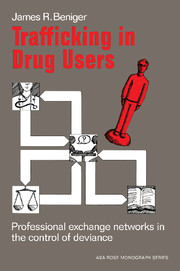Book contents
- Frontmatter
- Contents
- Acknowledgments
- Introduction
- 1 The emergence of the “drug problem”: social change versus social control
- 2 Control systems from exchange in networks: toward a synthesis of system and action theory
- 3 Stratification in information and referral exchange
- 4 Exchange relationships in social-control systems
- 5 The social system: boundary maintenance and hierarchical control
- 6 Summary: the control system in context
- Appendix A The data set
- Appendix B Subgroup sampling and estimated-density spaces (EDS)
- Notes
- Bibliography
- Name index
- Subject index
5 - The social system: boundary maintenance and hierarchical control
Published online by Cambridge University Press: 07 May 2010
- Frontmatter
- Contents
- Acknowledgments
- Introduction
- 1 The emergence of the “drug problem”: social change versus social control
- 2 Control systems from exchange in networks: toward a synthesis of system and action theory
- 3 Stratification in information and referral exchange
- 4 Exchange relationships in social-control systems
- 5 The social system: boundary maintenance and hierarchical control
- 6 Summary: the control system in context
- Appendix A The data set
- Appendix B Subgroup sampling and estimated-density spaces (EDS)
- Notes
- Bibliography
- Name index
- Subject index
Summary
One shortcoming of the progressive development of the control-system model in Chapters 3 and 4 is that its various aspects and dimensions were considered in relative isolation. Chapter 3 concerned the stratification of professions and hence confined its attention to relative or predominant directions of information and referral flows (which determine the exchangedominance hierarchy). Chapter 4, in contrast, was concerned with the division of interpersonal exchanges into subsystems and the analysis of relationships among these subsystems; hence it focused on the absolute sizes of flows.
These two distinctly different approaches of Chapters 3 and 4 are justified because the chapters set out to establish two quite separate conditions for cybernetic control at the level of autonomous systems – at the level of professions qua professions, and of groupings of professions in organizational sectors and functional subsystems. Chapter 3 demonstrated that information and referrals convey opposite statuses in exchange relationships, thus establishing hierarchy within the system. The other necessary conditions for a cybernetic system, boundary maintenance and the functional interrelationship of various specialized components, were established in Chapter 4.
Success in the piecemeal testing of various propositions in Chapters 3 and 4, however, does not necessarily assure the overall fit of the control-system model. What are undetected local deviations, in the test of one proposition or dimension of the model, may contribute to a favorable test of another proposition or dimension – which itself obscures other important local deviations (just as, for example, the correlational tests in Tables 4.11 and 4.12 may obscure local deviations among commodity-sector-directional types).
- Type
- Chapter
- Information
- Trafficking in Drug UsersProfessional Exchange Networks in the Control of Deviance, pp. 139 - 157Publisher: Cambridge University PressPrint publication year: 1984



